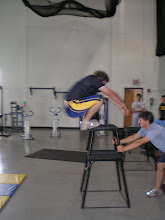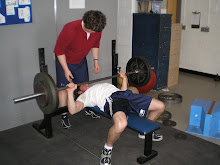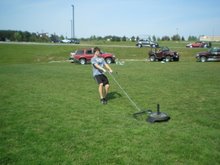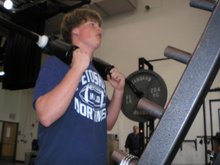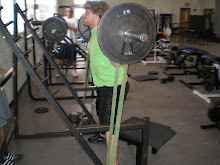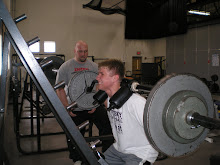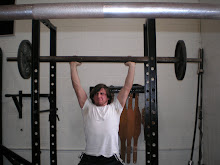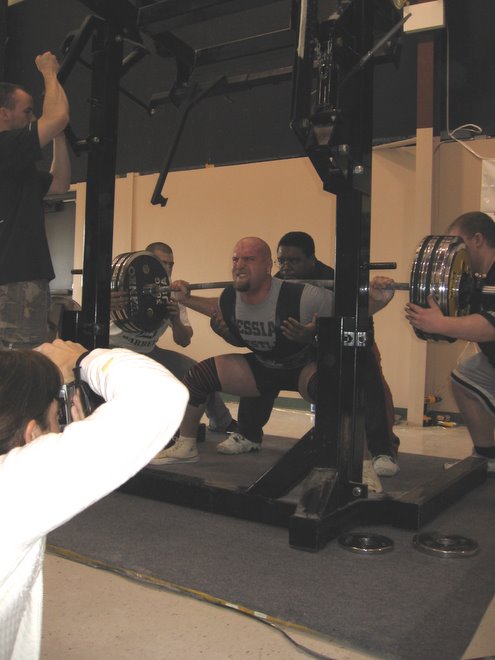Friday, November 30, 2007
Kneeling Jumps
This is an exercise I read about the other day from Jeremy Frey, and here is the video of him performing the lift. I really like this because you have to have explosive hips in order to make it to the feet, so I have been using it to help teach triple extension in regards to O-lifts.
This is a great post by Joe Defranco. I have said this many times, you need to train at the level you are. CLICK HERE!
Wednesday, November 28, 2007
Teaching cont...
I wanted to show some vids of the snatch. I am implementing this into the program for some of my CHS kids. Since i am unable to demonstrate the movement due to my knee I wanted the guys to see it full speed.
Training points- watch the speed, triple extension (ankle, knee, and HIP)how long the arm waits to bend, and depth of the catch.
Practice does not make perfect, PREFECT PRACTICE makes perfect.
Training points- watch the speed, triple extension (ankle, knee, and HIP)how long the arm waits to bend, and depth of the catch.
Practice does not make perfect, PREFECT PRACTICE makes perfect.
Tuesday, November 27, 2007
Funny, but not...

Its sad but true that this type of thing actually goes on and in many cases athletes or clients are actually instructed to do this. Some people(trainers) think that doing exercise like this is "functional" or "sports specific." BULL! I have said it many times and will continue to, the only thing that is sports specific, is practicing a sport. Wrapping a band around your wrist and trying to throw a football will not improve you passing ability, and in fact will probably hinder it. Anyway, my point is people have been becoming great athletes for years, so an entirely new system is not needed, we just need to find what works best for each athlete using the methods that have been proven to work.
The comic is posted on www.powerliftingwatch.com and is updated every once in a while and quite amusing, you can check out the whole series.
Tuesday, November 20, 2007
Maybe a new article
This is a great article, and the thing is I know that I have posted it before but I could not find it. Every point is dead on, and well worth reading and rereading.
Top 10 Speed Training Myths Revealed
By Patrick Beith
For www.EliteFTS.com
Every day someone asks me a question about training speed. So here are those questions heard most frequently as well as the answers to them.
1. Static stretching prepares you for competition/practice.
Static stretching actually reduces power output. Athletes should prepare for practice by doing a dynamic warm up that progresses from basic, low intensity movements to faster, more explosive movements as the muscles loosen up. The goal is to simulate movements that athletes will be using in practice or a game. What happens when you try to stretch a cold rubber band? You can think about your muscles the same way.
2. Strength training makes females too bulky
Many of the female athletes we train have this popular mindset. However, look at some elite female athletes like Mia Hamm or Lisa Leslie. They certainly train with weights, but no one would accuse them of having manly physiques. Strength training will improve performance and reduce injury if done correctly.
3. You can’t train speed.
For some reason, the popular belief is that you’re born with a certain amount of “speed” and you can’t improve it. Nothing could be further from the truth. Most young athletes are so physically weak and mechanically out of tune that significant improvements in speed can be made often just by working on technique and form. Athletes at any age and any level can improve speed when implementing a complete speed training program designed to improve and develop the entire athlete. {Use the link http://www.completespeedtraining.com/ for the words “speed training” in the last sentence.}
4. Training slow makes you fast.
I don’t think coaches directly think this way but their training techniques imply otherwise. This is especially true in sports that involve a higher aerobic element such as soccer, field hockey, or lacrosse. I see kids out running mileage and doing long, slow intervals of several minutes of continuous running. This will get them in shape. However, in games, I see kids jogging, jogging and then sprinting at full speed for 20–30 yards. Then they run, jog, and sprint for 20–30 more yards. If you want kids to improve their acceleration and top speed so that they can get to the ball faster or get back on defense, you have to train by running at full speed in practice.
5. You must train hard every day.
The workout itself is only a piece of the training puzzle. It’s the time between intense workouts—the recovery—where athletes make their improvements. Generally, it takes 36–48 hours to recover from high intensity training. If athletes are doing too much too often, they become overtrained. Coaches can expect to see an increase in injuries, complaints about being sore more often, decreased performance, and higher levels of fatigue earlier in games. It’s always better to under train an athlete than overtrain. Err on the side of caution to get maximal results.
6. Strength training will stunt a young athlete’s growth.
This is another myth held over from a different time. On a daily basis, kids as young as seven years old are playing organized sports year round. They’re tackling, getting tackled, sliding, and falling. These loads on the body can have a much greater physical impact than a well-designed strength training program. Though we don’t usually begin training with weights with prepubescent athletes, they can benefit from body weight exercises such as push-ups, lunges, and sit-ups. This will increase muscular efficiency, speed up recovery, and improve coordination and overall speed.
7. The harder the workout, the better the result.
Some athletes (and coaches) have this mentality that if a workout doesn’t reduce them to complete exhaustion and/or make them vomit, it wasn’t an effective workout. I can tell you that those who have this mentality probably see many injuries and frustrating performances. The purpose of a workout is to stimulate an adaptation by the body. If the body is forced to do too much work in a given time period, it will break down. The skill in coaching is to stimulate the adaptation in the body without reaching a point of diminishing returns.
8. Interval training is the same as speed training.
Repeatedly running 100s, 200s, etc. won’t improve top speeds. Even running repeat 40s with short recovery periods won’t improve acceleration and top speed. Speed work is defined as 2–8 seconds of maximal intensity running with full recovery. That means there should be at least two minutes of light dynamic movement between each effort. This goes against the experience of some coaches but is the only way to improve speed. An athlete must be able to focus on proper form and maintain intensity in order to get faster. If they don’t recover properly from each interval, they won’t be able to replicate proper mechanics with consistency and they can’t improve.
9. Flexibility won’t help you get faster.
Both coaches and athletes spend so much time on the skills of their sport, speed training, and conditioning, they often forget a fundamental component of success—flexibility. After practice or a game, the muscles are warm and loose. This is the time to work on increasing flexibility. So many athletes suffer injuries or compete below their capacity because poor flexibility inhibits their range of motion and speed. We see this in the hips and hip flexors where the stride lengths of athletes appear conspicuously short. Most often we see this in male athletes who will lift weights, train hard, and then skip out on their cool down and flexibility work.
10. Lift your knees.
When parents and coaches want their kids to run faster or when the kids are beginning to fatigue, I hear many yell at the kids, “Lift your knees. Get your knees up.” This is one of the most backward cues that we can give to athletes. The way to run faster is to apply more force to the ground. Every action has an equal and opposite reaction so the more force that you apply to the ground, the more the ground will give back. So when we cue athletes to lift their knees, we’re doing two things incorrectly. One, we’re telling them to use their hip flexors to lift instead of their glutes and hamstrings to drive down. Just think about the size of your hip flexor versus the size of your glutes and hamstrings. Now which muscles do you think can create more force and therefore more speed?
Second, we’re cueing them to do a movement that is in opposition to what generates speed. If an athlete learns at age seven to lift his knees when he needs a burst of speed, the improper cue will be hardwired into his brain. To unlearn that as a teenager and to do the opposite and drive down will delay the athlete’s progress. He or she will have a difficult time coordinating an entirely new way of running and will potentially have to take a step or two backward. That’s why it’s critical to learn proper form early and get an advantage over those who still aren’t getting the best instruction. So cue athletes to step over the opposite knee and drive the foot down into the ground with the foot landing underneath the hip.
Patrick Beith is the co-owner of Athletes’ Acceleration, Inc. He holds his bachelor’s of science degree in exercise physiology and is recognized by the National Strength and Conditioning Association (CSCS), the National Academy of Sports Medicine (PES), the American College of Sports Medicine (HFI), the International Youth Conditioning Association (IYCA), and the USA Track and Field Coaching Level II (jumps, sprints, hurdles, and relays).
Elite Fitness Systems strives to be a recognized leader in the strength training industry by providing the highest quality strength training products and services while providing the highest level of customer service in the industry. For the best training equipment, information, and accessories, visit us at www.EliteFTS.com.
Top 10 Speed Training Myths Revealed
By Patrick Beith
For www.EliteFTS.com
Every day someone asks me a question about training speed. So here are those questions heard most frequently as well as the answers to them.
1. Static stretching prepares you for competition/practice.
Static stretching actually reduces power output. Athletes should prepare for practice by doing a dynamic warm up that progresses from basic, low intensity movements to faster, more explosive movements as the muscles loosen up. The goal is to simulate movements that athletes will be using in practice or a game. What happens when you try to stretch a cold rubber band? You can think about your muscles the same way.
2. Strength training makes females too bulky
Many of the female athletes we train have this popular mindset. However, look at some elite female athletes like Mia Hamm or Lisa Leslie. They certainly train with weights, but no one would accuse them of having manly physiques. Strength training will improve performance and reduce injury if done correctly.
3. You can’t train speed.
For some reason, the popular belief is that you’re born with a certain amount of “speed” and you can’t improve it. Nothing could be further from the truth. Most young athletes are so physically weak and mechanically out of tune that significant improvements in speed can be made often just by working on technique and form. Athletes at any age and any level can improve speed when implementing a complete speed training program designed to improve and develop the entire athlete. {Use the link http://www.completespeedtraining.com/ for the words “speed training” in the last sentence.}
4. Training slow makes you fast.
I don’t think coaches directly think this way but their training techniques imply otherwise. This is especially true in sports that involve a higher aerobic element such as soccer, field hockey, or lacrosse. I see kids out running mileage and doing long, slow intervals of several minutes of continuous running. This will get them in shape. However, in games, I see kids jogging, jogging and then sprinting at full speed for 20–30 yards. Then they run, jog, and sprint for 20–30 more yards. If you want kids to improve their acceleration and top speed so that they can get to the ball faster or get back on defense, you have to train by running at full speed in practice.
5. You must train hard every day.
The workout itself is only a piece of the training puzzle. It’s the time between intense workouts—the recovery—where athletes make their improvements. Generally, it takes 36–48 hours to recover from high intensity training. If athletes are doing too much too often, they become overtrained. Coaches can expect to see an increase in injuries, complaints about being sore more often, decreased performance, and higher levels of fatigue earlier in games. It’s always better to under train an athlete than overtrain. Err on the side of caution to get maximal results.
6. Strength training will stunt a young athlete’s growth.
This is another myth held over from a different time. On a daily basis, kids as young as seven years old are playing organized sports year round. They’re tackling, getting tackled, sliding, and falling. These loads on the body can have a much greater physical impact than a well-designed strength training program. Though we don’t usually begin training with weights with prepubescent athletes, they can benefit from body weight exercises such as push-ups, lunges, and sit-ups. This will increase muscular efficiency, speed up recovery, and improve coordination and overall speed.
7. The harder the workout, the better the result.
Some athletes (and coaches) have this mentality that if a workout doesn’t reduce them to complete exhaustion and/or make them vomit, it wasn’t an effective workout. I can tell you that those who have this mentality probably see many injuries and frustrating performances. The purpose of a workout is to stimulate an adaptation by the body. If the body is forced to do too much work in a given time period, it will break down. The skill in coaching is to stimulate the adaptation in the body without reaching a point of diminishing returns.
8. Interval training is the same as speed training.
Repeatedly running 100s, 200s, etc. won’t improve top speeds. Even running repeat 40s with short recovery periods won’t improve acceleration and top speed. Speed work is defined as 2–8 seconds of maximal intensity running with full recovery. That means there should be at least two minutes of light dynamic movement between each effort. This goes against the experience of some coaches but is the only way to improve speed. An athlete must be able to focus on proper form and maintain intensity in order to get faster. If they don’t recover properly from each interval, they won’t be able to replicate proper mechanics with consistency and they can’t improve.
9. Flexibility won’t help you get faster.
Both coaches and athletes spend so much time on the skills of their sport, speed training, and conditioning, they often forget a fundamental component of success—flexibility. After practice or a game, the muscles are warm and loose. This is the time to work on increasing flexibility. So many athletes suffer injuries or compete below their capacity because poor flexibility inhibits their range of motion and speed. We see this in the hips and hip flexors where the stride lengths of athletes appear conspicuously short. Most often we see this in male athletes who will lift weights, train hard, and then skip out on their cool down and flexibility work.
10. Lift your knees.
When parents and coaches want their kids to run faster or when the kids are beginning to fatigue, I hear many yell at the kids, “Lift your knees. Get your knees up.” This is one of the most backward cues that we can give to athletes. The way to run faster is to apply more force to the ground. Every action has an equal and opposite reaction so the more force that you apply to the ground, the more the ground will give back. So when we cue athletes to lift their knees, we’re doing two things incorrectly. One, we’re telling them to use their hip flexors to lift instead of their glutes and hamstrings to drive down. Just think about the size of your hip flexor versus the size of your glutes and hamstrings. Now which muscles do you think can create more force and therefore more speed?
Second, we’re cueing them to do a movement that is in opposition to what generates speed. If an athlete learns at age seven to lift his knees when he needs a burst of speed, the improper cue will be hardwired into his brain. To unlearn that as a teenager and to do the opposite and drive down will delay the athlete’s progress. He or she will have a difficult time coordinating an entirely new way of running and will potentially have to take a step or two backward. That’s why it’s critical to learn proper form early and get an advantage over those who still aren’t getting the best instruction. So cue athletes to step over the opposite knee and drive the foot down into the ground with the foot landing underneath the hip.
Patrick Beith is the co-owner of Athletes’ Acceleration, Inc. He holds his bachelor’s of science degree in exercise physiology and is recognized by the National Strength and Conditioning Association (CSCS), the National Academy of Sports Medicine (PES), the American College of Sports Medicine (HFI), the International Youth Conditioning Association (IYCA), and the USA Track and Field Coaching Level II (jumps, sprints, hurdles, and relays).
Elite Fitness Systems strives to be a recognized leader in the strength training industry by providing the highest quality strength training products and services while providing the highest level of customer service in the industry. For the best training equipment, information, and accessories, visit us at www.EliteFTS.com.
Thursday, November 15, 2007
Girls with UPS...
Tuesday, November 13, 2007
Quick and Simple
This is a very general, but practical LIST, I especially like #8. There is a difference between becoming faster, and becoming conditioned.
Thursday, November 8, 2007
And I use to like Coke...
What Happens To Your Body Within An Hour Of Drinking A Coke
October 24th, 2007 Nutrition Researchers Posted in Food Science Research |
Don’t drink cola if you want to be healthy. Consuming soft drinks is bad for so many reasons that science cannot even state all the consequences. But one thing we know for sure is that drinking Coke, as a representative of soft drinks, wreaks havoc on the human organism. What happens? Writer Wade Meredith has shown the quick progression of Coke’s assault.
The main problem is sugar. It’s an evil that the processed food industry and sugar growers don’t want people to know about. Even dietitians, financially supported by sugar growers and sugary product manufacturers, are loathe to tell us the truth.
When somebody drinks a Coke watch what happens…
In The First 10 minutes: 10 teaspoons of sugar hit your system. (100% of your recommended daily intake.) You don’t immediately vomit from the overwhelming sweetness because phosphoric acid cuts the flavor allowing you to keep it down.
20 minutes: Your blood sugar spikes, causing an insulin burst. Your liver responds to this by turning any sugar it can get its hands on into fat. (There’s plenty of that at this particular moment)
40 minutes: Caffeine absorption is complete. Your pupils dilate, your blood pressure rises, as a response your livers dumps more sugar into your bloodstream. The adenosine receptors in your brain are now blocked preventing drowsiness.
45 minutes: Your body ups your dopamine production stimulating the pleasure centers of your brain. This is physically the same way heroin works, by the way.
60 minutes: The phosphoric acid binds calcium, magnesium and zinc in your lower intestine, providing a further boost in metabolism. This is compounded by high doses of sugar and artificial sweeteners also increasing the urinary excretion of calcium.
60+ Minutes: The caffeine’s diuretic properties come into play. (It makes you have to pee.) It is now assured that you’ll evacuate the bonded calcium, magnesium and zinc that was headed to your bones as well as sodium, electrolyte and water.
60+ minutes: As the rave inside of you dies down you’ll start to have a sugar crash. You may become irritable and/or sluggish. You’ve also now, literally, pissed away all the water that was in the Coke. But not before infusing it with valuable nutrients your body could have used for things like even having the ability to hydrate your system or build strong bones and teeth.
So there you have it, an avalanche of destruction in a single can. Imagine drinking this day after day, week after week. Stick to water, real juice from fresh squeezed fruit, and tea without sweetener.
Primary Source: by Wade Meredith
October 24th, 2007 Nutrition Researchers Posted in Food Science Research |
Don’t drink cola if you want to be healthy. Consuming soft drinks is bad for so many reasons that science cannot even state all the consequences. But one thing we know for sure is that drinking Coke, as a representative of soft drinks, wreaks havoc on the human organism. What happens? Writer Wade Meredith has shown the quick progression of Coke’s assault.
The main problem is sugar. It’s an evil that the processed food industry and sugar growers don’t want people to know about. Even dietitians, financially supported by sugar growers and sugary product manufacturers, are loathe to tell us the truth.
When somebody drinks a Coke watch what happens…
In The First 10 minutes: 10 teaspoons of sugar hit your system. (100% of your recommended daily intake.) You don’t immediately vomit from the overwhelming sweetness because phosphoric acid cuts the flavor allowing you to keep it down.
20 minutes: Your blood sugar spikes, causing an insulin burst. Your liver responds to this by turning any sugar it can get its hands on into fat. (There’s plenty of that at this particular moment)
40 minutes: Caffeine absorption is complete. Your pupils dilate, your blood pressure rises, as a response your livers dumps more sugar into your bloodstream. The adenosine receptors in your brain are now blocked preventing drowsiness.
45 minutes: Your body ups your dopamine production stimulating the pleasure centers of your brain. This is physically the same way heroin works, by the way.
60 minutes: The phosphoric acid binds calcium, magnesium and zinc in your lower intestine, providing a further boost in metabolism. This is compounded by high doses of sugar and artificial sweeteners also increasing the urinary excretion of calcium.
60+ Minutes: The caffeine’s diuretic properties come into play. (It makes you have to pee.) It is now assured that you’ll evacuate the bonded calcium, magnesium and zinc that was headed to your bones as well as sodium, electrolyte and water.
60+ minutes: As the rave inside of you dies down you’ll start to have a sugar crash. You may become irritable and/or sluggish. You’ve also now, literally, pissed away all the water that was in the Coke. But not before infusing it with valuable nutrients your body could have used for things like even having the ability to hydrate your system or build strong bones and teeth.
So there you have it, an avalanche of destruction in a single can. Imagine drinking this day after day, week after week. Stick to water, real juice from fresh squeezed fruit, and tea without sweetener.
Primary Source: by Wade Meredith
Subscribe to:
Comments (Atom)










